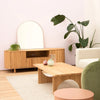
Returns & Refunds
Read moreIn an age where you can (affordably) video-call your cousin on the opposite side of the world and (not-so-affordably) get a Michelin-quality meal delivered to your door, you’d think the human race has the keys to contentment in our collective hand. Spoiler alert: this is wildly untrue. But if we’ve got access to more cool stuff and mind-blowing technology than ever before, why are so many people so deeply unhappy?
For every modern innovation and convenience we’ve been afforded, something gets taken away. From social media to 24/7 access to news cycles, we’ve paid the price via mental health issues, lower self-esteem, stolen focus and various other psychological scarring. In fact, Beyond Blue cites that almost a third of Australians will experience an anxiety condition in their lifetime — a statistic worrying in itself. So, yeah, when you look at the root of the issue, it makes sense that a lot of folks are fundamentally bummed out — but we’re certainly not a lost cause.
The secret to a happier life may have been hiding under our noses for literal centuries — yup, we’re talking feng shui! While it’s certainly not a new concept, this oft-oversimplified Chinese practice has more relevance than ever before. Boasting core principles that are practically tailor-made to chill us out, feng shui is all about harnessing energy forces to create harmony between people and the spaces they inhabit.
So, is the only thing standing between you and a healthier mind the position of your couch? Not exactly, but we’re here to deep dive into the power of feng shui and how it can help you live happier.
What exactly is feng shui? It goes a lot deeper than just moving your furniture around — and the key to unlocking its benefits lies in respecting its roots. The term "feng shui" translates to "wind-water" in English, reflecting its emphasis on the harmonious flow of energy (Qi) in the environment.
Developed by ancient Chinese philosophers, the practice initially aimed to align human dwellings with the natural forces of the universe to promote balance and prosperity. Fast-forward to the Han dynasty (206 BCE–220 CE), and feng shui started to take on more structure and context, incorporating principles from astronomy, geography and Chinese cosmology.
In the 20th century, feng shui experienced a revival both in China and internationally — and it’s still having quite the moment. Modern practitioners blend traditional principles with contemporary design to enhance wellbeing and harmony in various settings.
Today, feng shui continues to be a widely practised and influential philosophy, shaping the design and arrangement of spaces to create positive environments. While the world has changed monumentally since the inception of feng shui, its core principles are still hyper-relevant — perhaps more than ever before.
The ancient art of feng shui is further backed up by modern psychological facts and studies. It probably comes as no surprise that our environment affects our wellbeing — but to what extent can a physical space and its contents influence your mood?
According to BetterHelp, research has shown that the psychology of certain interior design choices can indeed have a significant impact on our mental health. Fields like design psychology and the psychology of space have developed to help us create spaces that prioritise peace, wellness and calm — essential elements to consider in today’s extremely stressful climate.
The principles of feng shui largely intersect with the modern practice of design psychology. They are each based on the same fundamental truth that our surroundings impact our wellbeing. While each discipline is different, there are some interesting overlaps between the two.
When we interviewed Psychologist Chris McDermott for this article, he elaborated that: “Feng shui's emphasis on balance and nature resonates with psychological notions of stress reduction and emotional balance. Integrating these principles into design not only enhances aesthetics but also positively impacts occupants' mental states, contributing to a holistic sense of wellbeing. It's a fascinating intersection where design and psychology converge to shape our emotional experiences within our living spaces.”
The significance of natural elements, a focus on spatial arrangements, the role of lighting and the importance of decluttering are four core pillars that appear in both disciplines.
The neuroscience behind the psychology of design lends an extra layer of credence to the art of feng shui — which may be dismissed by some as being less legitimate due to its spiritual roots.
We also consulted with Dr. Mark Williams, a Professor of Cognitive Neuroscience, who notes that behavioural and brain imaging research back up the link between our spaces and our mental health: “Designing your living space to harmonise with your natural environment is really important for brain health. It has been shown that the design of your home can decrease cortisol and stress as well as improve mood and intelligence.”
Ready for a crash course in how feng shui can shape your design choices? One of the most significant aspects of the practice is the traditional Chinese five elements — wood, fire, earth, metal and water — the pillars of the discipline. These are fundamental forces believed to shape the universe and influence the flow of energy (Qi). Each element has its unique characteristics, associations and interactions with other elements.
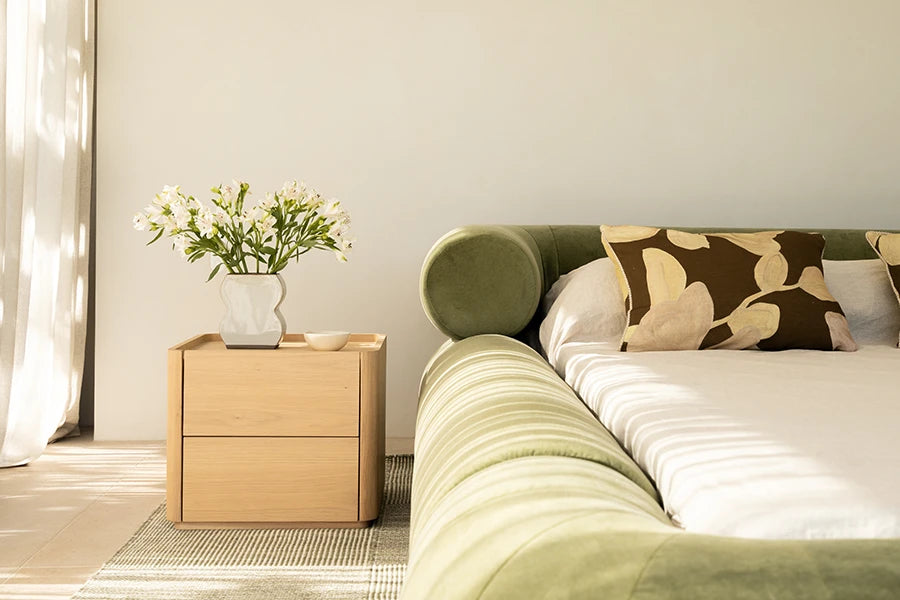
Wood may seem like a no-brainer way to incorporate feng shui elements into your decor, but it goes beyond just the physical material. This element is associated with growth, vitality and flexibility — it’s linked to the colour green and represents the spring season.
The Vibe: Natural materials, plants and greenery, vertical lines and columns, a green colour palette, flexibility and open spaces.
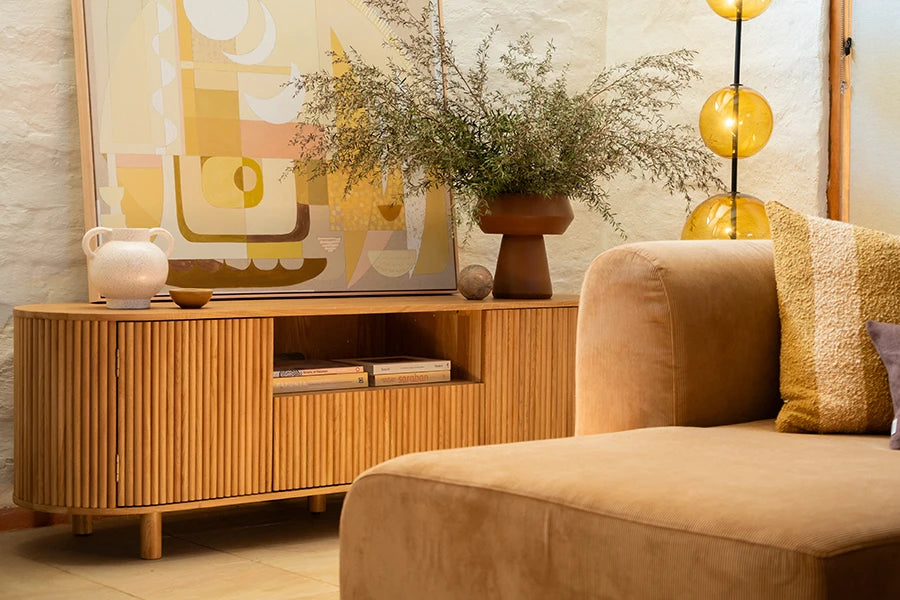
As you might suspect, the fire element is responsible for bringing the heat via qualities like passion, energy, transformation and warmth. The aim here is to foster a vibrant and lively atmosphere. It's vital to strike a balance when incorporating the fire element, ensuring the overall design remains harmonious and doesn't become overly intense.
The Vibe: Warm and bold colours (reds, oranges, purples), emphasis on lighting, triangular or pointed shapes.
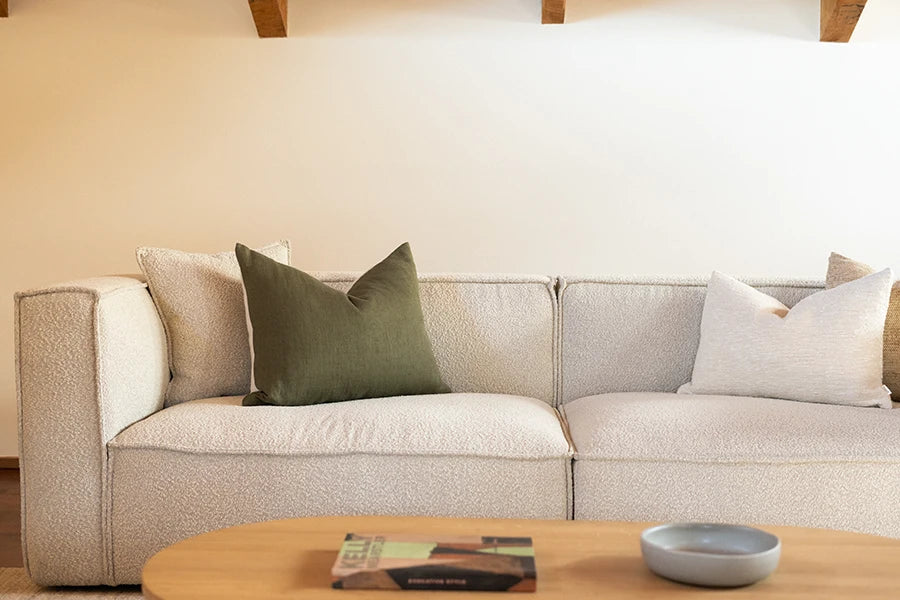
In feng shui, the earth element is associated with stability, nourishment and grounding energy — all coveted attributes for a home’s overall atmosphere. Focusing on this element can enhance a space's balance and create a harmonious environment.
The Vibe: Earthy colours, organic materials (clay, stone, ceramic), square and rectangular shapes.
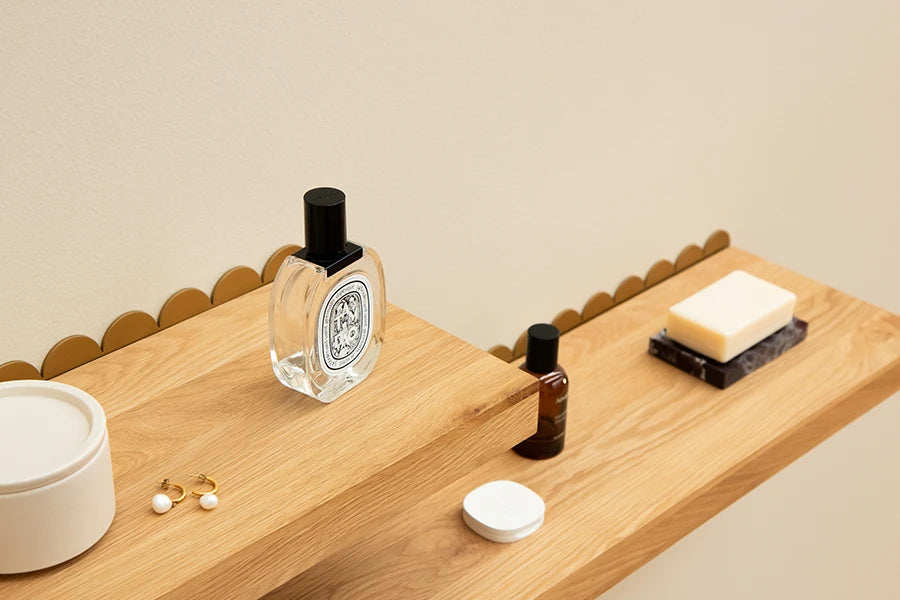
Got a thing for clarity, precision and efficiency? The metal element is calling to you! This element should have a solid presence in areas where focus is your priority — looking at you, home office.
The Vibe: White and metallic colours (gold and silver), metallic finishes, circular shapes and patterns, minimalism.
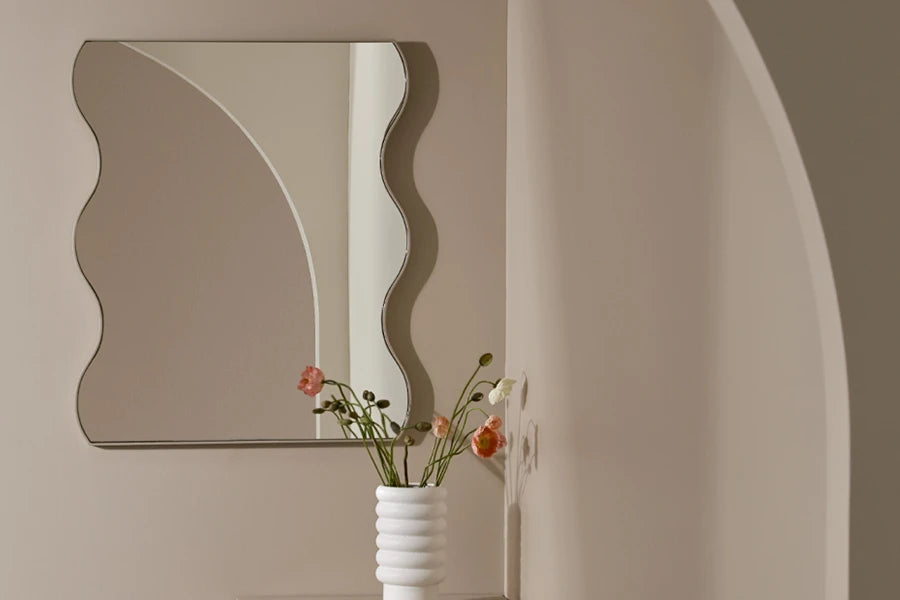
Let it flow — energy, abundance and purification, that is. As you might have guessed, the water element is all about cleansing and refreshing — focusing on this aquatic energy will promote harmony, balance and positivity.
The Vibe: Water features, mirrors, blue or black tones, curvy and flowing shapes, bamboo or aquatic plants, glass and reflective surfaces.
In feng shui philosophy, a harmonious balance among the elements is the key to creating the right energy flow and wellbeing in a space. It’s not as simple as ticking off a checklist for each individual element — you need to consider how they work together.
So, how do you analyse the interactions and cycles between the elements to create spaces that are truly harmonious? The answer is …
he bagua map is your not-so-secret weapon to strike the right balance between the five Chinese elements in your space. The term "bagua" translates to "eight areas" or "eight trigrams" in English, and it refers to an octagonal map that divides a space into eight sections, each corresponding to a different aspect of life. This fundamental feng shui tool can guide you to design and decorate your space according to the discipline’s best practices.
To put it into more familiar terms, think about the concept of yin and yang — it’s all about balancing different energies to create your ideal outcome. Feng shui seeks a harmonious balance between yin (calm, receptive) and yang (active, vibrant) energies. Achieving this equilibrium in design can create an environment that supports emotional wellbeing.
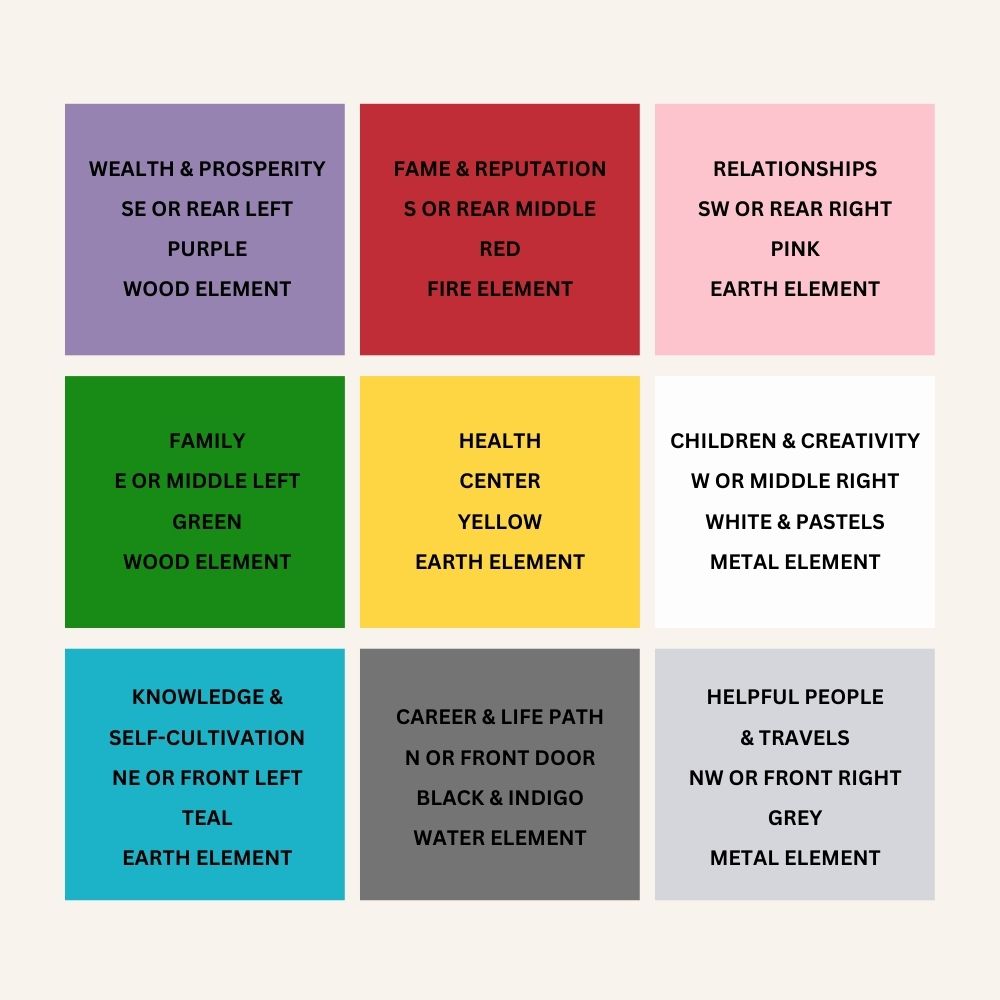
So, how does it work? The bagua map is superimposed onto a floor plan of a home, room or outdoor space, aligning with the main entrance. Each of the eight sections, or guas, is associated with specific life areas and elements:
Career (North): Associated with the Water element.
Knowledge (Northeast): Associated with the Earth element.
Family (East): Associated with the Wood element.
Wealth (Southeast): Associated with the Wood element.
Fame (South): Associated with the Fire element.
Relationships (Southwest): Associated with the Earth element.
Children (West): Associated with the Metal element.
Helpful People/Travel (Northwest): Associated with the Metal element.
It may be an ancient practice, but feng shui has endless applications in today’s modern design landscape. Interior designer Trish Khoury from Grace Interior Designs says, “Just like interior design, feng shui has key principles. However, the best actionable advice to apply feng shui is to follow your intuition and what feels good.” Essentially, don’t be put off by thinking you have to go all-in — take elements of the practice that speak to you and craft a space that makes you happy.
Kiah Bouchet, a professional home organiser, adds the following wisdom: “When you start to play around with the furniture, you kind of realise that it's not just about being a perfect, balanced home — it actually functions better when you follow those [feng shui] principles.”
In a nutshell: Follow the Bagua. Feng shui is all about furniture arrangement and object placement to optimise energy flow within a space. The layout of your home can affect the flow of energy and emotions. An open, uncluttered layout encourages a sense of freedom and tranquility, while cramped spaces can lead to tension and unease.
Good feng shui encourages the presence of natural light and fresh air — we’re talking large windows, open floor plans and the use of mirrors to reflect light. However, Trish cautions to be mindful of your mirror placement: “Use them if they reflect something beautiful.
Don’t use mirrors opposite main entrance doors. In this position, mirrors deflect and
reject all energy — even good energy — from entering your house.”
Great news if you’re drawn to minimalism — this design style aligns with the feng shui principle of keeping spaces organised and clutter-free. Intelligent storage solutions and efficient organisation contribute to a sense of order and balance, so don’t be afraid to channel your inner Marie Kondo.
Using artwork and symbolism is a great way to incorporate the five elements without going overboard. Things like clay vases or pottery for earth, an image of a seascape or river for water, or even candles for fire are all subtle ways to integrate this elemental vibe into your space.
We’ve already covered the link between design and psychology, but it’s worth mentioning the impact that colour has on our mood. Modern design can leverage colour psychology to create atmospheres that bring a particular energy to a room.
The profound impact that colours can have on our mood cannot be understated, no matter how subtly or overtly those colours are incorporated into a space. A feng shui approach to colour selection can help create an atmosphere that matches the desired emotional state. For example, soothing blues may be used for relaxation, while energetic reds can be incorporated for areas promoting activity.
Keen to give the whole feng shui thing a try in your own space? We’ve got some examples of feng shui done fabulously.
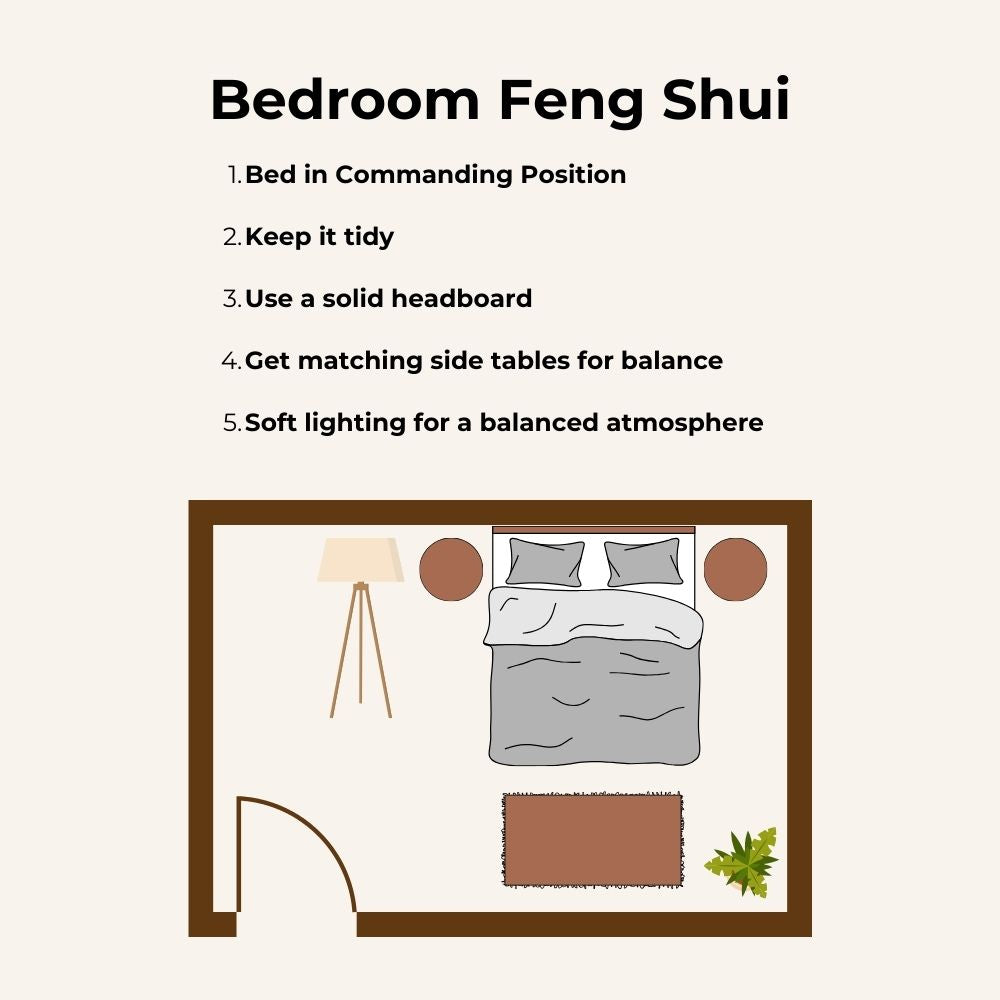
We spend almost a third of our lives sleeping (or trying to), so it certainly makes sense to optimise our bedroom vibes. RJ Living’s own Trade Manager Bree Steele emphasises that this space should prioritise balance, harmony and symmetry.
Bed Placement
Position the bed so it has a clear view of the bedroom door, but avoid placing it directly in line with the door – this is the famous “commanding position”.
Place the bed against a solid wall for support and stability. Avoid positioning the bed under a window.
Balanced Energy Flow
Ensure there is a balanced energy flow around the bed. Avoid clutter or obstructions under the bed.
Use a solid headboard to provide a sense of support and protection. Avoid headboards with slats or openings.
Bree suggests placing matching bedside tables and lamps on either side of the bed: “[This] can create a balanced environment conducive to relaxation and peaceful sleep," she explains.
Lighting
Opt for soft lighting to create a relaxing atmosphere. Avoid harsh overhead lights. Trish recommends floor lamps with warm-toned bulbs — anything with ambient light and gentle curvature promotes a peaceful vibe that will still correct any dark corners.
Use bedside lamps with soft, warm-toned bulbs to promote a cosy ambience.
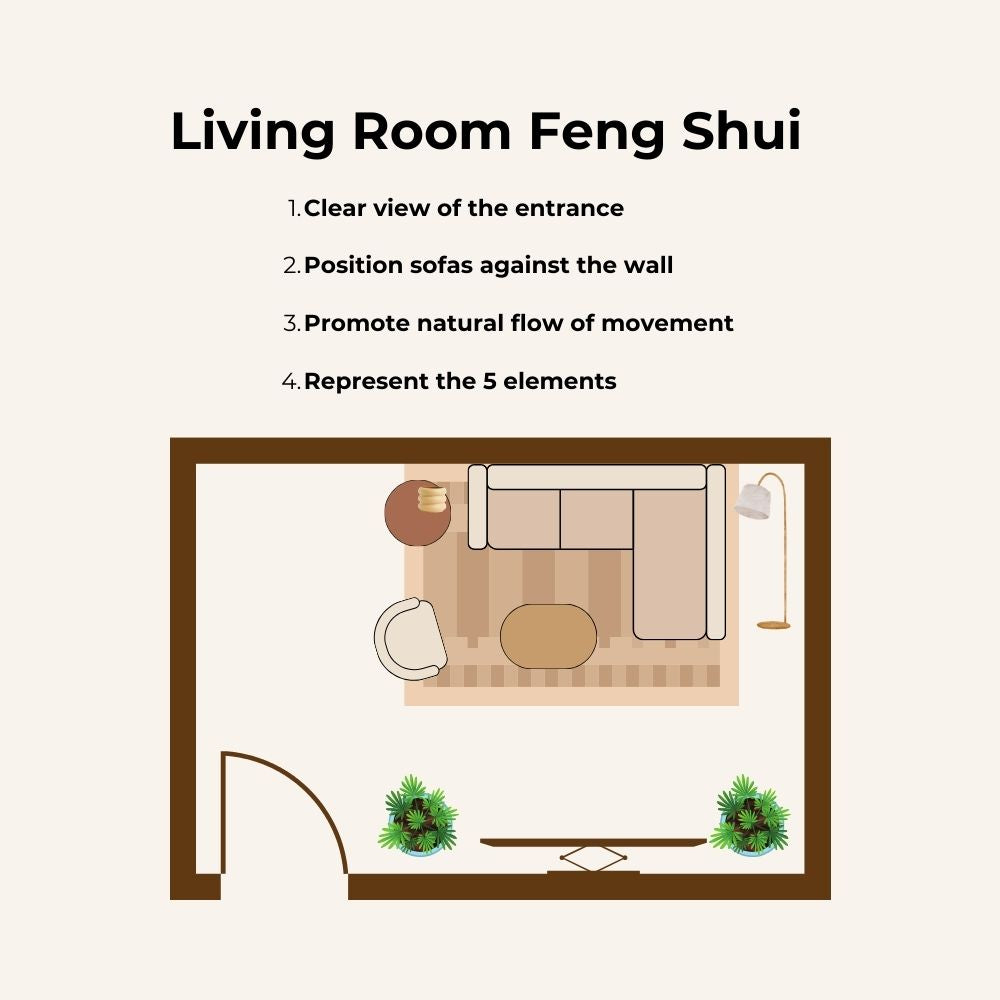
Another common feng shui hotspot is the living room, as it’s the centre of our social interactions. The different function of this space means a different approach is needed as opposed to the bedroom — here, it’s more about connection, community and activity.
Furniture Positioning
Position the main seating area in a way that allows for a clear view of the entrance without having your back directly facing the door. This promotes a sense of security and control. Kiah says, “Sofas with high protective sides will make us feel safer in a space - particularly when positioned against a wall.”
Arrange furniture to create a balanced and welcoming conversation area. Avoid placing furniture in a way that obstructs the natural flow of movement within the room.
Balance of Elements
Incorporate a balanced representation of the five elements as per the bagua. Experiment with different materials, textures and colours to represent each element.
Trish’s tip? “Use colours and materials in the bagua that identify the related elemental connection to correct any areas in your space. For example, a plant (north-east for earth) or ceramics (south for fire).”
The crux of feng shui is making considered choices about your environment. At RJ Living, we’re passionate about thoughtful, timeless and happiness-inducing design — the sort of pieces that can turn your space into a sanctuary of wellbeing. Investing in quality furniture and accessories is a crucial foundational step for crafting a place where you can feel like you’re living your best life — then you can arrange it to level up your serotonin.
Not sure where to start? We offer consultations with expert interior designers who can help you create the harmonious, functional and truly happy place of your dreams. Bree was recently featured in Best Living regarding her feng shui skills, so you can move forward knowing that aesthetics and good vibes will both be factored into your space! Get in touch with our team today and start your journey to a more balanced life.
Chris McDermott - Psychologist, Advanced Practice Registered Nurse Autonomous Practice (APRN-IP) & Certified Life Care Planner (CLCP)
Chris has over 13 years of active clinical practice treating adult and gerontology patients recovering from trauma and surgery as well as practice in sleep medicine.
Dr. Mark Williams - Cognitive Neuroscientist
Mark is a professor of cognitive neuroscience at Macquarie University and has over 25 years of experience conducting behavioural and brain imaging research.
Trish Khoury - Interior Designer & Founder of Grace Interior Designs
Trish has a Diploma in Interior Design from The Interior Design Institute in London
Kiah Bouchet - Professional Home Organiser & Owner of ‘Declutter with Kiah’
Kiah has completed Form and Compass school in Feng Shui, via the Australian College of Environmental Studies.